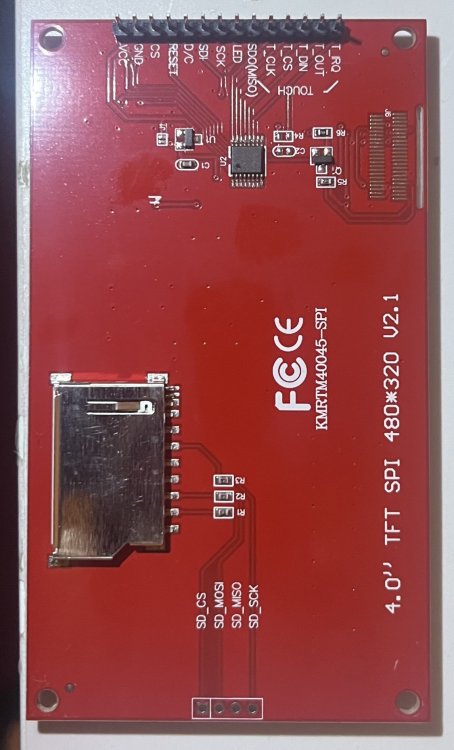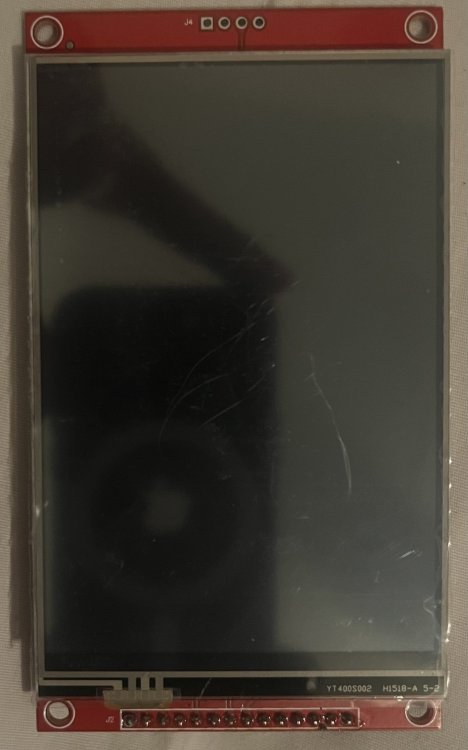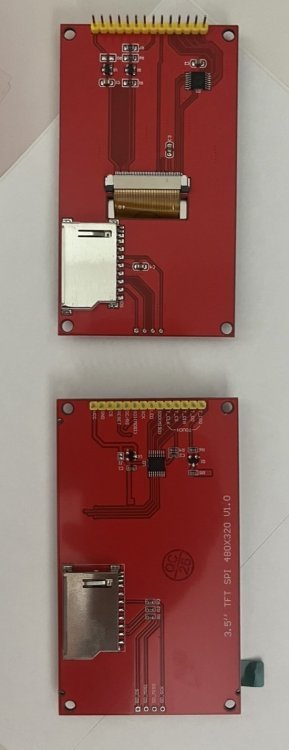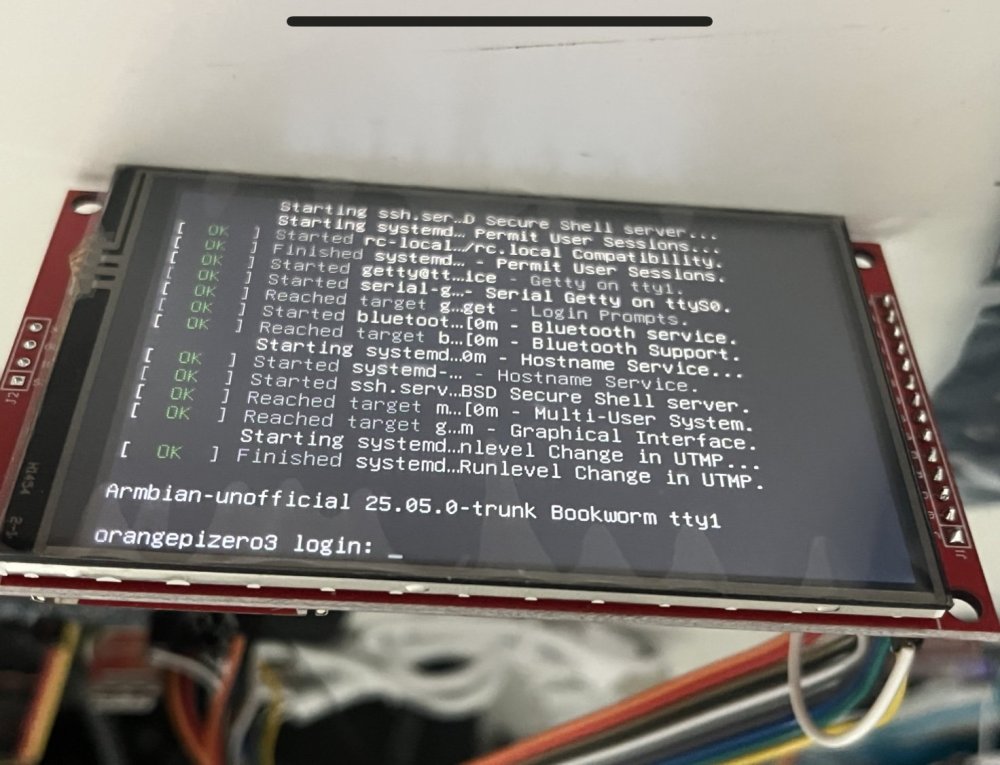
robertoj
Members-
Posts
561 -
Joined
-
Last visited
Content Type
Forums
Store
Crowdfunding
Applications
Events
Raffles
Community Map
Everything posted by robertoj
-

Orangepi Zero 2W wrong color display on MPI3501
robertoj replied to Minh Tiến Nguyễn's topic in Allwinner sunxi
Nice Are you going to use apps that will need high fps? If so, comment about the performance. Does the touch function feel steady and reliable? (dragging windows without jumpiness, with the stylus) The app for keyboard emulation with touch screen is "matchbox", if you need it. -

Orangepi Zero 2W wrong color display on MPI3501
robertoj replied to Minh Tiến Nguyễn's topic in Allwinner sunxi
I am glad you could do it with the orange pi zero 2w, because I also want to use a very small arm board I am having trouble with the red ili9488 red LCD's touch function, and if I keep having no results, I will replace with the waveshare LCD model (I wanted to have 4-inch LCD ) What armbian and linux version did you use? If you go to the latest linux, you may need to modify the DTS a little bit (modifications are in my ili9488 thread). Warning: I use a different driver (parameter "compatible") for DRM graphics, and different drivers might need different DTS lines. Always use a different microSD for experiments, so you don't mess with your working setup Does the orange pi zero 2w just need male pin headers on the 40-pin connector, and then plug the LCD on top? -

OrangePi Zero LTS ili9341 TFT LCD (and later OrangePi Zero 3)
robertoj replied to robertoj's topic in Allwinner sunxi
i answered in your thread. -

Orangepi Zero 2W wrong color display on MPI3501
robertoj replied to Minh Tiến Nguyễn's topic in Allwinner sunxi
https://forum.armbian.com/topic/46824-orange-pi-zero-3-ili9486-tft-lcd/ user wdr_s had success with that same lcd. Try it with linux 6.1 (check the success case) If you have a file named orangeEnv.txt... you arent using armbian yet! Make sure to use armbian-add-overlay In the ili9341 or ili9488 there's someone trying with orange pi zero 2w, which is very close to zero 3 -

Driving the ili9488 LCD (4.0 inch cheap chinese clone)
robertoj replied to robertoj's topic in Allwinner sunxi
I just did some new experiments, trying to get touch working in ili9488 LCD v2.1 Increasing or decreasing the SPI MHz in both the LCD and touch section of the DTS DONT WORK... I couldn't get touch working Next is to use a software defined SPI with spi-gpio (based on my experience in my ili9341 thread) does anybody know a Python soft spi program which can talk to ads7846/xpt2046? update: I am getting some good touch results with Raspberry, which I hope I can transfer to opiz3. https://forums.raspberrypi.com/viewtopic.php?t=389230 -

OrangePi Zero LTS ili9341 TFT LCD (and later OrangePi Zero 3)
robertoj replied to robertoj's topic in Allwinner sunxi
I was having some trouble with newer ili9488 LCD v2.1, and I didn't have ili9488 LCD v1.1, so I decided to experiment again with ili9341 LCD v1.2. I found that this DTS https://forum.armbian.com/topic/44191-orangepi-zero-lts-ili9341-tft-lcd-and-later-orangepi-zero-3/#findComment-204672 Doesn't work with the touch chip. By accident, I ran the ili9488 driver on this ili9341, and I saw garbled graphics... but the good news: touch was working. Something in the ili9488 DTS which doesn't work for the ili9488 LCD, works for ili9341. I found the difference was not in the ads7846 section, but in the spi speed for the ili9xxx part. I switched back to the ili9341 DTS (with adafruit driver), but changed the SPI speed from 24MHZ to 40MHz.... then the ili9341 DTS was working with graphics and touch again ALTHOUGH the graphics have some flashing pseudo-colors in some places. Maybe the 40MHZ is too much, but I re-gained touch in ili9341 LCD v1.1. I will keep doing experiments. Playing with the SPI Mhz didn't help with the ili9488 -
I don't know what else to do... I usually research and learn on the go Search the 88xxau.c in your downloaded linux source. Try to find any link to documentation or github. Search 8812au in the respberry pi forum
-
That github page tells you that the in-kernel driver is better than morrownr's driver. Have you tried that first? Search for rtw88 in the /lib/modules folder Try rebuilding armbian, find rtw88 or 8812au in the linux configuration menu and activate them.
-
Was this 8812au.ko in the lib/modules folder originally, or did you copy it from somewhere else?
-

Driving the ili9488 LCD (4.0 inch cheap chinese clone)
robertoj replied to robertoj's topic in Allwinner sunxi
I finally got time to test my new ili9488 4.0 inch LCD (red, version 2.1)... the graphic display works, but the touch doesn't I see the interrupts number increasing (with watch -n0.1 cat /proc/interrupts , focusing on the line with ads7846) I also see that some people in the arduino community short diode D1, or else the SPI second slave wont work https://github.com/Bodmer/TFT_eSPI/discussions/898 Is anyone here working with a new SPI LCD? How could I see logs specific for the ads7846 kernel driver? update: this LCD does not have a D1 diode, and it looks like this According to this Amazon link, this LCD board should have a flat cable through the "slot hole" near the top right. https://www.amazon.com/Display-Module-ILI9488-480x320-Equipped/dp/B0D92DSCMG -
In the final lines of your build log output, it seems that it cant download some ubuntu packages. I dont see linux compilation errors (I only looked at it for 1 minute). Can you try rebuilding with debian?
-
drivers/net/wireless/rtl8192eu/hal/phydm/phydm.c seems like a linux source file... maybe this warning was shown AFTER uboot finished compiling?
-

Audio no longer works after updating to Armbian 24.8.2
robertoj replied to PHLAK's topic in Radxa Rock Pi S
Can you compare the device tree between your working system, and from the freshly installed 25.2.3/6.12.22 (write the img in a new microSD) View your device tree with: #(root) dtc -I fs -O dts /sys/firmware/devicetree/base (you need to find out which driver handles the audio, and search for that driver name in the working device tree) Also, check differences in armbianEnv.txt Also, check differences in ".config" in the /boot/ folder (specially anything related to audio) Also check the contents of "dmesg", searching for the audio driver name -
The orange pi zero LTS has analog video under Armbian, because: * the LibreElec project had kernel patches that added the driver code for the same SBC * I carefully modified those patches so they would fit the Armbian version of Linux, correct all compilation errors, and all errors I saw. * another member of this community transformed it into a pull request to the armbian project, and the admins approved it My part was a month long effort If you see that Radxa has video output in the official distribution, do you see any source changes to enable it?
-

OrangePi Zero LTS ili9341 TFT LCD (and later OrangePi Zero 3)
robertoj replied to robertoj's topic in Allwinner sunxi
Is anyone using the orange pi zero LTS or 3, with any ilitek LCD, with spi-gpio driver? I had my LTS working with ili9341 and spi-gpio last year... but the touch is not working now... I think I changed the wiring or the DTS in the running system but I can't tell. -

Driving the ili9488 LCD (4.0 inch cheap chinese clone)
robertoj replied to robertoj's topic in Allwinner sunxi
Does anyone know if the spi-cpol and spi-cpha parameters are applicable in the ads7846 part of the DTS? I have seen cpol in an LCD discussion here: https://forum.armbian.com/topic/38896-orange-pi-lite-problem-with-latest-firmware/#findComment-191293 I am running out of ideas to try to make touch work... I can also try using gpio-spi.ko I need to check that the IRQ pin is changing from 3.3 to 0V... if I connect a LED to it, will it be a 0.0V pulse or held low while I press my finger? I learnt that /proc/interrupts can tell me if the IRQ input is seeing something... and I can see the number increase each time I press my finger on the screen: (see the line that ends with ads7846) https://forums.raspberrypi.com/viewtopic.php?t=187023&start=25 Is there any way to debug the ads7846 kernel module? I have seen this J1jumper mentioned here: https://forum.arduino.cc/t/solved-3-5-tft-not-stable-at-power-up/684536/19 "if you jumper J1, you feed it with 3.3V" I power it with 3.3V and the J1 contacts are disconnected... so maybe the 7846 is undervolted... does anyone have experience with this? -

Driving the ili9488 LCD (4.0 inch cheap chinese clone)
robertoj replied to robertoj's topic in Allwinner sunxi
I received my new LCD today. It is a 9486 but luckily it worked with my 9488 dts HOWEVER: The touch xpt2046/ads7846 is not sending any events…checking with evtest… same dts works with the ili9488 4.0” I already tried changing the GPIO polarity (level and clock transition) has anyone worked with any of the red 3.5 lcd ili9488 or 9486 -
I don't think increasing the SPI clock can help Try adding "BGR=<1>;" under the rotation line... this works for the ili9341, but i dont know about the driver that you use.
-
Great find.... this will be useful for me very soon
-
Try again with Linux 6.10 or older if you have an armbian img. Two things I found needed for linux 6.12+: 1. Define the pinctrl-names and pinctrl-0 parameters 2. MAYBE: rebuild Armbian in your computer, with one less Armbian patch As seen in: https://forum.armbian.com/topic/47971-driving-the-ili9488-lcd-40-inch-cheap-chinese-clone/#findComment-216779 In this thread, you can see how I detected miscofigurations of the SPI GPIO: https://forum.armbian.com/topic/50418-dont-use-kernel-61216-on-sunxi64/page/2/#findComment-216924 WDR_s: did you try upgrading to Linux 6.12? (you could get H264 acceleration if you upgrade)
-
pithecanthrope, That DTS is specific for the raspberry pi lcd... not for the red pcb ili9486. Do you have that? You can name the DTS any filename, for example ~/ili9486/ili9486-35.dts cd ~/ili9486-35 sudo armbian-add-overlay ili9486-35.dts The command will also add it to armbianEnv.txt Make sure to not add any other overlays related to SPI It is very nice that the raspberry pi lcd doesn't need us to fabricate a custom cable, just plug it in the correct orientation. Are you using Linux 6.12?
-

Making Armbian more embedded
robertoj replied to Peter Allen's topic in Software, Applications, Userspace
Start with a minimal image: no X11, no desktop sudo systemctl list-units --type=service --all Find those services you don't need, and "sudo systemctl disable <service>" Is buildroot a nice experience like armbian? -
I have an IoT project that uses an SPI LCD (480x320), showing 1 full screen application on top of X11, which starts automatically, almost in kiosk mode. Is it worth a lot trying to switch to Wayland? I have 2 roadblocks, which I am trying to drill through: * tkinter app re-write in pyqt * starting from a minimal armbian image, and install the bare minimum to have wayland and start the app Solid advantage: * Future proofing the product I have these preconceived advantages: * less resources needed: my application is fine with an OrangePi Zero 3 with 1 GB RAM, I don't want to upgrade RAM * faster startup (now I need to wait 1 minute from power-on to app ready to use, reducing it to 30 seconds would be nice) I know that I can't expect these advantages, since I use SPI instead of HDMI or DSI: * 30 FPS * No frame tearing But really, my main objective is faster startup: will Wayland help me with that? (without having disadvantageous side effects)
-

Ethernet stop working after delay on Orange Pi PC+ with SSD
robertoj replied to lamenace's topic in Allwinner sunxi
Can you connect with a USB-serial adapter, then run dmesg and look for error messages? Maybe the power supplies are not isolated and by some bad luck, they are trying to push electrons to each other on the 0V wire. Try using the SSD without its own power supply. -
I will get an ili9486 soon, but it is different to yours: it has a red PCB and does not have the serial-to-parallel chip like those made for raspberry.




